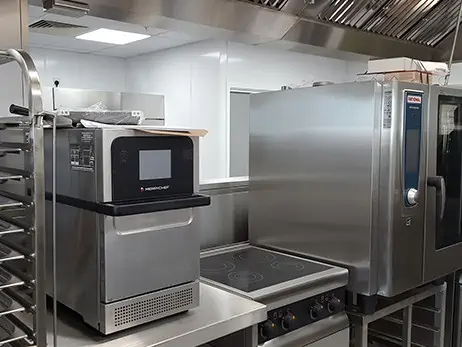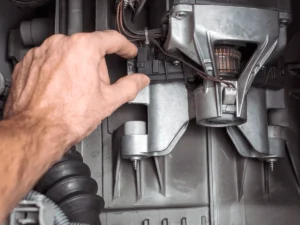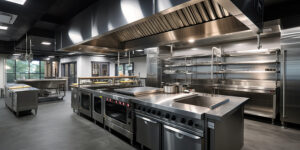Commercial Kitchen Design
At Abraxas we have over 20 years’ experience in the field of commercial kitchen design and know how vital good design is to the overall success of your foodservice business. Whether you’re planning a new design from scratch or a make-over of an existing facility, there are several things to consider. The type of food service provider that your business is aiming to be will determine the concepts behind the design of your commercial kitchen to maximise the available space and resources and enable the efficient working of your team. When fitting out a kitchen it is vital that professional kitchen equipment meets all the regulations stipulated for safe food preparation, for example that the extraction and ventilation systems meet legal requirements.
With hands-on experience in the food preparation industry, our team at Abraxas have a wealth of experience you can draw on to create the most innovative kitchen. They are also well qualified to help you fit out and supply all the relevant equipment you will need. And with our maintenance and servicing plans we really are your complete design and installation service.
Kitchen design services for commercial projects
Abraxas offers a complete turnkey service for commercial kitchen design. The initial stage will be creating a CAD design with one of our experienced design team members. With a strong background in the catering industry and up to date qualifications in the legalities, our team are perfectly placed to advise you on the best layout to enable your catering team to work productively as well as the best equipment to install.
There are so many additional factors to consider in the design of your kitchen. Health and safety, sustainability as well as the latest trends in cooking equipment, such as induction technology, mean that an expert to support you throughout the project is invaluable. We work within your time and budgetary constraints to produce the best possible outcome in designing and installing your new commercial kitchen. We understand the priorities of energy, materials and labour efficiency and are able to take you through the process as painlessly as possible to create a kitchen your staff love to work in, and which supports good workflow and service to your customers.
Design Guidelines
Storage
Storage in a commercial kitchen ranges from raw, cooked and frozen foods which need to be kept separated to prevent contamination and at correct temperatures. Other storage that needs considering is for dry products, spare stock and equipment. These need to be kept in a cool space where moisture won’t affect or spoil them.
Food preparation
The preparation area of a kitchen needs to be carefully designed to prevent potential cross contamination of raw and cooked foods and also of food that might contain allergens. It is important to plan this area carefully as health inspectors will be looking to see that food hygiene is a priority.
Meal cooking
The cooking area needs to be as well-designed as possible to prevent chefs from having to move around too much. This is important for the safety of staff as cooking equipment is very hot and carries greater risk of injury. A vital part of the commercial kitchen is the extraction and ventilation system which is also in the cooking area of the kitchen in order to extract fumes, steam and odours safely outside. There are important legal requirements to adhere to with this aspect of the kitchen, and a specialist is necessary.
Service
The service or ‘front of house’ space needs to be away from the food preparation, cooking and cleaning areas and it is unhelpful if serving staff have to pass through these areas of the kitchen, so innovative design is essential to ensure that staff aren’t wasting time and energy avoiding each other, and accidents, in their various functions within and outside of the kitchen.
Cleaning and washing
Cleaning and washing up is an essential part of the whole food preparation and hygiene process. Staff handwash stations need to be at strategic points around the kitchen to enable them to clean their hands regularly. The cleaning of cooking and serving equipment needs to be separate from the food preparation area to prevent contamination.
Waste management
Managing the waste from your commercial kitchen is important and needs to be handled in order to ensure there is no contamination of food being prepared or surfaces and equipment within the kitchen. Within the kitchen it is important to have a designated area for general waste and recycling away from the food preparation area. Colour coded bins and cleaning equipment can prevent cross-contamination and need to be stored for easy access.
Commercial Kitchen Layout
How your commercial kitchen is configured will be vitally important to the workflow of the kitchen and the staff working within it. The physical shape of the space will dictate, to some extent, the way that the equipment can be laid out, but getting the areas of food preparation, cooking and serving and clean up in the right places for ergonomic working is key.
Assembly line
This type of kitchen layout is perfect for a restaurant or café which is producing a lot of the same type of dish over and over, such as a pizza parlour or sandwich shop. Ideally there are multiple chefs each responsible for one part of the process to make it as ergonomically productive as possible.
Galley
In the galley kitchen, the equipment and workstations are on the perimeter of the kitchen and in a very small space, such as a food truck or pod, equipment is only along two parallel walls which allows staff to move between different areas of the kitchen easily.
Island Style
An island style kitchen consists of a free-standing block in the middle of the main area which is often the cooking area with food preparation, storage, cleaning and kitchen-to-service areas around the perimeter of the kitchen. It can, however, be reversed with prep equipment in the centre. The most important criteria for this type of layout is in having ample space for staff to move around the island.
Zone Style
A zone kitchen layout is what it says on the tin, different zones for the different processes of food preparation and cleaning. These are often laid out in the ‘golden triangle’ of kitchen design developed by the University of Illinois School of Architecture in the 1940s, which keeps the three zones separate to give staff the most efficient space to work in and allowing multiple types of foods to be prepared simultaneously.
Open kitchen
An open kitchen is where the customers can see the preparation process and enables the creation of the food to become part of the dining experience, although it is vital to keep the hot, cooking appliances further away from customers for safety and hygiene reasons.
Design Considerations
Temperature Control
Temperature within a kitchen needs to be optimized for the comfort of staff and the safe running of equipment. A good extraction and ventilation system will go a long way to helping regulate the temperature of the kitchen and is also a legal requirement.
Health and safety
Health and safety are a vital element in the planning of a commercial kitchen. Staff need full training on waste disposal, cleaning, notifying of hazards, such as wet floors, and also knowledge of fire safety and first aid. There should be fire exits and extinguishers easily accessible and regularly serviced by a licensed person. All equipment for the implementation of health and safety within the kitchen should be planned into the design.
Ergonomic kitchen flow
Flow of movement within the kitchen isn’t only the staff working within it. When deliveries arrive, there should be space for goods to enter the kitchen without impacting the running of the kitchen or creating a hazard or interruption to the flow of service.
Spacial planning
Spatial planning involves thinking carefully about the size and shape of the kitchen alongside the practical demands of the number of staff working within it as well as the type and volume of food that the kitchen will be serving. These variants create a unique requirement every time, needing a skilled design.
Storage
Storage is one of the biggest considerations in the planning of a commercial kitchen, as there are many things needing different storage solutions. There needs to be enough fridge and freezer space for raw and cooked foods, and to enable them to be kept separate from each other. Storage is also needed for dry goods, surplus stock, cleaning materials and kitchen equipment such as utensils, pans, plates, glasses and cups and more.
Staff communication
When designing your commercial kitchen, it is important to consider how staff can communicate with each other as this will help to improve efficiency and training amongst staff. If the kitchen is segregated into walled-off areas this is prevented and certain catering types, such as fast food environments will require a higher level of communication between staff than others.
Installation and supply
Once the design is in place for the equipment and zones of the kitchen, there are other decisions needed for the installation of elements of the space, such as the lighting, walls, flooring, pipe work and other materials.
Good lighting is essential to kitchen safety and natural light is ideal, although in the winter and evenings this can’t be relied upon, so a good level of lighting is needed. Walls need to be resistant to food, grease and dust and wipeable so that good hygiene can be maintained.
Flooring should be anti-slip and also cleanable and coving to join floor and walls can prevent the build up of dust and dirt in crevices. Other materials for equipment and pipe work will also need to be regularly cleaned and stainless steel is a common option as it is very easy to keep hygienic.

Catering Equipment
The size and amount of equipment your commercial kitchen will need will depend on the size of the kitchen, the planned menu and clientele to be served. Part of the design will be planning zones for the different types of activity within the kitchen and the equipment needed for those activities needs to be grouped in the relevant areas for quick access and effective preparation and service. There would be little point in putting the dishwasher in the food preparation area as it would entail staff getting in each other’s way in order to fulfil their different roles. It makes sense for the end of the food preparation area to be where front of house staff can easily collect the plates to deliver to the customers without having to cross other preparation and cleaning zones and will ensure the food reaches the customer more quickly – no one likes cold food!
Abraxas will not only install but also service the equipment to keep it functioning as new.
Kitchen design for your industry

School and education
Educational establishments like schools are aiming to produce a large quantity of food within a short space of time, so planning needs to factor in these issues as well as facilities to keep food warm in the service area.

Restaurants and dining
Commercial kitchens in the restaurant sector need to have the space and equipment for a larger team and ability to produce a greater difference of menu options which will impact the design of the space.

Cafes and Deli
Not needing such a large or diverse amount of equipment, these kitchens still need to be thought through for workflow space, clever storage and preparation areas.

Hospitals and care homes
As with schools, hospitals and care homes are needing to output a large volume of food within a small window of time, so ergonomic flow and space for keeping food warm is a priority.

Pubs and bars
The type of menu that the pub or bar is intending to serve will create different requirements for the equipment and areas within the kitchen, creating parameters for the design process.
Learn more about commercial kitchen designs from Abraxas
How big does a commercial kitchen need to be?
A commercial kitchen needs to be big enough to house all the appropriate equipment that will ensure you’re following the proper regulations, including storage space, waste management, cleaning and washing up stations, food preparation areas, and catering equipment. For more information, please follow our guide on commercial kitchen design.
How many sinks are needed in commercial kitchen design?
Every commercial kitchen will require at least two sinks – one for washing up and sanitising equipment, with the other being a designated hand-washing sink for employees. Larger commercial kitchens may have more than two sinks, including several hand-washing sinks for larger groups of employees.
Are floor drains required in commercial kitchens?
Floor drains are typically required in commercial kitchens because commercial kitchens have specific sanitation requirements and generate a significant amount of wastewater and other liquids that need to be disposed of. Floor drains prevent water, grease, and other liquids from pooling on the floor which creates safety hazards and attracts pests.
What is the best flooring to use in a commercial kitchen design?
The best flooring solution in a commercial kitchen is to use anti-slip material, flooring that can be cleaned easily and should have a covering to join floors and walls to prevent the build-up of dust and dirt in crevices.
Will you install the catering equipment you include in my commercial kitchen design?
Yes, our engineers are more than happy to install the catering equipment including gas and electrical appliances, as well as ventilation and extraction systems.
Want to know more about Abraxas Kitchen Design
Learn more about the Commercial Kitchen design services Abraxas offer.
EXCELLENTTrustindex verifies that the original source of the review is Google. Excellent service and support, to help keep the kitchen and bar in service, particularly during the crucial busy periods.Trustindex verifies that the original source of the review is Google. Its been a great company to work with, there support from the initial meeting through the procurement /planning stage, delivery, install and completion was very professionally handled. The employees of the company couldn't accommodate you any more that they did, they always went the extra mile.Trustindex verifies that the original source of the review is Google. Very helpful and understanding. Quick to attend breakdownsTrustindex verifies that the original source of the review is Google. Abraxas support and service is exceptional from planned maintenance, remedial works, through to brand new installations. They are quick to react and always there to offer any support you need to overcome problems or come up with solutions. They are competitive with their pricing and will work with you to ensure a solution can be found within your budget. I have used abraxas for many years across multiple sites and would highly recommend them for all catering kitchens needs.Trustindex verifies that the original source of the review is Google. We had a commercial kitchen project undertaken by the team at ABRAXAS recently. Their team did a fantastic job from start to finish and we’re able to overcome issues and accommodate changes with ease. Special mention to Rob, Richard and Tom for their work on the project.Trustindex verifies that the original source of the review is Google. What a amazing company ,they supplied and fitted a new extraction canopy and cooker at my butchers shop recently ,they were exceptionally professional ,nothing was to much trouble and the two fitters were outstanding ,again courteous ,professional and exceptional obliging ,good old fashioned customer service , it was a pleasure to have them on the premises well done ! can definatley recommendTrustindex verifies that the original source of the review is Google. Great company to work with, lovely people. professional and highly knowledgeable of the industry.














